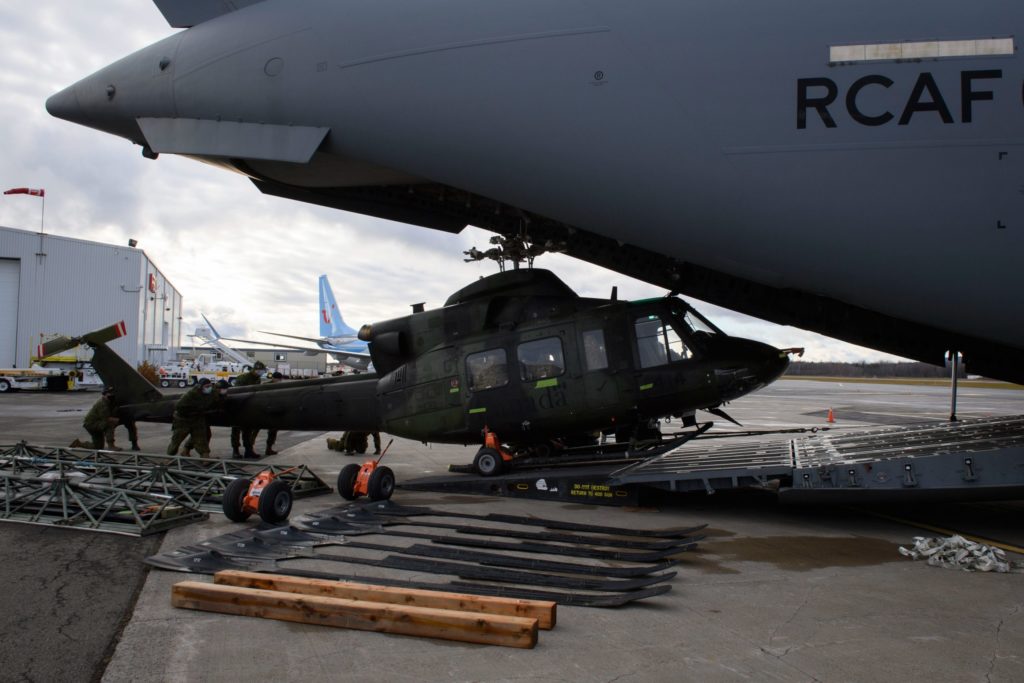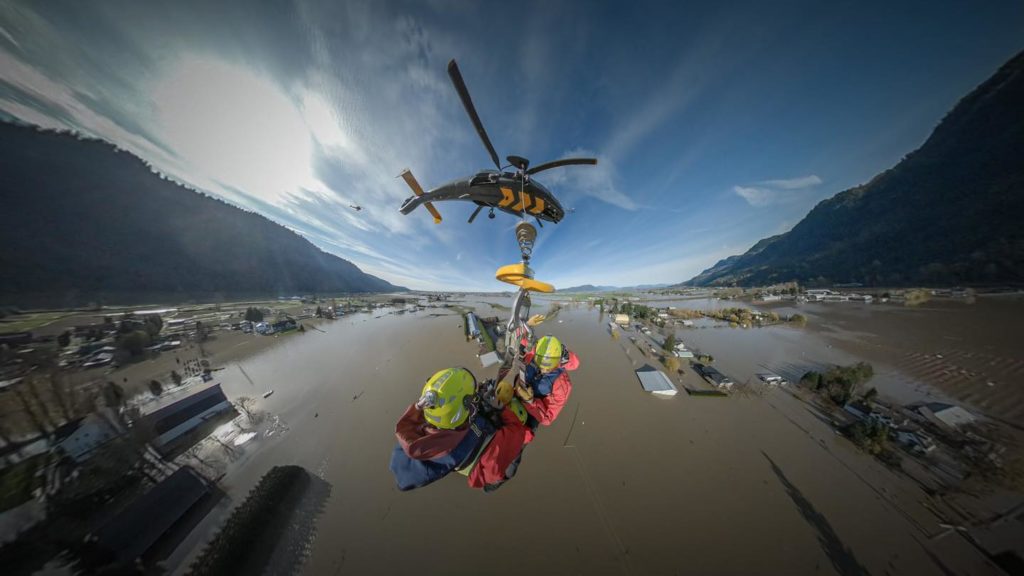Rescue and evacuation efforts in response to catastrophic flooding in British Columbia — already underway by a mix of military, commercial and private helicopters in the province — were reinforced over the weekend with the arrival of three Royal Canadian Air Force CH-146 Griffon helicopters aboard a CC-177 Globemaster.
The tactical aviation assets will join a sizable fleet of military, commercial and private aircraft that have moved tens of thousands of British Columbians out of the path of flooding that has overflowed highways and cut off some areas completely.

The three Griffons from 430 Tactical Helicopter Squadron at Canadian Forces Base Valcartier, Quebec, were transported rather than flown across the country because of their modest range and speed, the Canadian Armed Forces (CAF) said in a Twitter post announcing the deployment.
“Tactical helicopters like Griffons are invaluable in support of personnel movement and reconnaissance in domestic operations like [Operation] Lentus,” the codename for CAF responses to natural disasters in Canada. “But their relatively slow speed and short range make them less suited to cover long distances.”
The Griffons will join CH-146 helicopters from 408 Squadron in Edmonton, Alberta, which are already assisting relief efforts in B.C., the CAF said.
The province is under a two-week state of emergency as catastrophic flooding continues to wreck infrastructure, snarl roads and ports, and displace thousands of residents.
The state of emergency was declared Nov. 17 by Mike Farnworth, Minister of Public Safety, amid warnings of further flooding and landslides. It will remain in effect for 14 days but could be adjusted if conditions change.
Bill Blair, president of the Queen’s Privy Council for Canada and Minister of Emergency Preparedness lauded the “remarkable acts of compassion, courage and resilience” from civilians, armed forces personnel, mayors, police and fire chiefs and many others in the province since the flooding began.
“We are making significant progress on the ground, but it will take some time to fully recover from this disaster,” Blair said Nov. 21 on a conference call with reporters. “There have been some improvements; river levels are dropping, highways and rail lines are reopening with priority given to movement of essential goods.”
Minister of Transport Omar Alghabra echoed Blair in applauding all of the rescue efforts by civilians and military personnel, especially the coordinated air operations that evacuated hundreds of stranded motorists and First Nations members to safety.
“We have seen many inspiring moments of collaboration and caring,” he said, including “air operators dropping supplies, adding cargo capacity to reunite loved ones and keep critical goods moving.”
Although rivers are beginning to recede from the previous storm, the province is not out of the woods yet, Blair said. Another weather event is expected to bring between 20 and 40 centimeters (eight to 15 inches) of rain to areas of British Columbia on Monday and Tuesday.
Both in response to the ongoing flooding and in preparation for the future deluge, more than 500 Canadian Armed Forces personnel will be on the ground in B.C. by Monday, said Minister of Defence Anita Anand. A dozen aircraft — both helicopters and fixed-wing — are dedicated to the relief operation. Most were already in the province Sunday and more were on their way, Anand said.
This is the 12th natural disaster request for assistance the Canadian Armed Forces have responded to since the beginning of the Covid pandemic, she said.
“Over the weekend a large contingent of personnel were deployed to the Lower Mainland,” Anand said during the press call. “With regard to British Columbia, we are committed to the 30-day request for assistance but, if help is required for longer than the 30 days, we will be there to help for as long as it takes.”
CAF personnel are performing multiple missions, including evacuating stranded motorists, conducting damage assistance, rescuing livestock, route reconnaissance, and repairing critical infrastructure, Anand said. So far, they have delivered more than 3,000 pounds of food to stranded First Nations communities in B.C.
Gen. Wayne Eyre, acting chief of the Defence Staff, said British Columbia has not asked for more military assistance than it will have on Monday, Nov. 22, but that thousands more personnel are on standby should they be needed if conditions worsen.
As part of Operation Lentus, three CH-149 Cormorant helicopter crews from 442 Transport and Rescue Squadron at 19 Wing Comox on Nov. 15 helped evacuate more than 300 motorists who were stranded overnight in their cars by mudslides that made highways unpassable near Agassiz, about 120 kilometers (80 miles) east of Vancouver. Video of one Cormorant landing on a wooded roadway and evacuating civilians was widely circulated online.
As of Nov. 19, almost 18,000 people had been evacuated from flooded areas in the southwest and central regions of the province. A total 5,918 properties were ordered evacuated, and another 3,632 properties are on evacuation alert.
Assisting in the evacuation efforts are several commercial helicopter operators, including Whistler-based Blackcomb Helicopters. A tour and charter service provider, Blackcomb received hundreds of calls for transport since the flooding began, according to operations manager Andrew Bradley. Vancouver-based Talon Helicopters and Parksville-based Ascent Helicopters, among other commercial operators, also have responded to the floods by performing rescues, evacuations and emergency resupply.

“Roads are cut off, railways are compromised in a big way, so we’ve been getting a ton of phone calls from a lot of people who are stranded in Hope trying to get over the highway into Vancouver for various reasons,” Bradley told Vertical in a recent interview. “We’ve probably received upwards of 200 phone calls — and that’s just us — asking if we can come pick them up and get them across the highway into Vancouver.”
Blackcomb dispatched an Airbus AS350 AStar and a Bell 206B JetRanger to the area earlier last week to handle the volume of transport traffic. They were part of a fleet of what grew to a “couple dozen” commercial and private helicopters transporting passengers and evacuating people to safety from their flooded or damaged homes through the Emergency Management BC program, Bradley said. It made for some busy, crowded airspace between the small Hope airport and Vancouver.
“It was pretty hectic,” he said. “It was a bit of organized chaos . . . We only had a couple helicopters down there. After they came back . . . and after talking to my pilots . . . they said it was pretty busy. We’re commercial operators but there were also good Samaritans, private pilots in their planes trying to help out. So, you can image a mix of commercial and private; not to say the private pilots aren’t good people, but they’re not used to commercial service.”
“We actually opted not go in [Thursday] for that reason alone,” Bradley added.
The military is now coordinating all air operations out of Abbotsford International Airport and Chilliwack, according to Alghabra. In an effort to deconflict the airspace in that area, all aircraft are temporarily prohibited from flying below 1,000 feet (300 meters) between the two airports, Alghabra said Nov. 21.
Since the flooding began, Blackcomb also has been flying missions throughout the Lower Mainland of the province to make sure emergency infrastructure is up and running. The highway destruction from rains that were “unprecedented” — weather warnings predicted 230 millimeters (nine inches) of rain — is significant. The Coquihalla Highway, the main thoroughfare from Vancouver to the interior of the province, could be closed until summer 2022, said Bradley.
“We’ve had flooding in the past — we have actually trained for it with search-and-rescue members — but this one I think caught everyone a little off guard, just the intensity of what actually happened,” he said.
The state of emergency applies to the whole province and ensures federal, provincial and local resources can be delivered in a coordinated response to protect the public, which remains the provincial government’s top priority.









